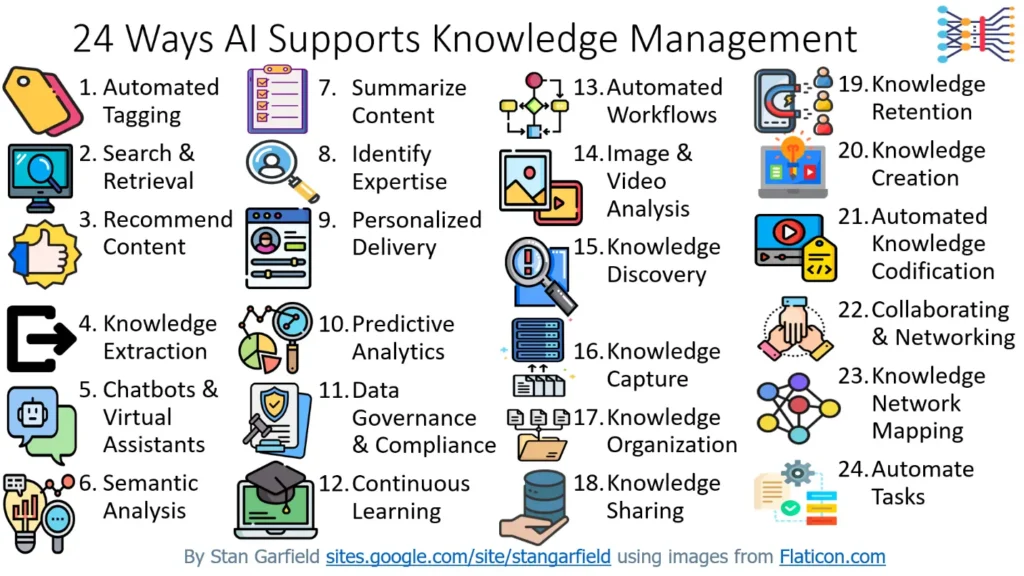36 Examples of How AI Can Support KM Processes

Stan Garfield
Artificial Intelligence (AI) can augment human knowledge work by automating time-consuming and difficult tasks. This allows people to focus on higher-value activities. AI becomes a collaborative partner in managing an organization’s knowledge.
To demonstrate this, I asked ChatGPT, Copilot, Claude, Gemini, and Pi the question: “How can AI support knowledge management?” This article includes content curated from the replies received from these tools.
24 Ways AI Can Support Knowledge Management
AI has an almost unlimited number of uses in support of knowledge management. Here are two dozen examples for general knowledge management.

Infographic Number 57 in Knowledge Nuggets: 100 KM Infographics
- Automated Content Categorization and Tagging: AI can automatically categorize and tag documents, articles, and other content based on their content, making it easier to organize and retrieve relevant information.
- Search and Retrieval: Advanced search algorithms powered by AI can enable more accurate and efficient information retrieval. Natural language processing (NLP) techniques allow users to search using natural language queries, making it easier to find specific information within a knowledge repository.
- Content Recommendation: AI can analyze user preferences and past interactions to recommend relevant articles, documents, or resources, thus improving knowledge discovery and dissemination.
- Knowledge Extraction: AI can analyze unstructured data sources like text documents, emails, and even audio recordings to extract valuable insights and knowledge. This can be particularly useful in identifying trends, sentiment analysis, and distilling information from large datasets.
- Chatbots and Virtual Assistants: AI-powered chatbots or virtual assistants can provide instant responses to common queries, guide users through knowledge repositories, and offer real-time support for information retrieval.
- Semantic Analysis: AI can analyze the semantic meaning of content, enabling it to understand relationships between concepts and providing more accurate context-based search results.
- Content Summary: AI can automatically generate concise summaries of lengthy documents, helping users quickly grasp the key points without reading the entire content.
- Collaboration and Expertise Location: AI tools can identify subject matter experts within an organization based on their contributions, interactions, and expertise. This helps facilitate collaboration and knowledge sharing.
- Content Personalization: AI can tailor content recommendations based on individual user roles, preferences, and history, ensuring that users receive information most relevant to their needs.
- Predictive Analytics: AI can analyze historical data to predict future trends, behaviors, and challenges. This can guide decision-making and knowledge management strategies.
- Data Governance and Compliance: AI can help ensure that knowledge management practices adhere to data governance and compliance standards by automatically identifying sensitive or confidential information.
- Continuous Learning and Improvement: AI can learn from user interactions and feedback, continuously improving its ability to provide relevant and accurate knowledge management support.
- Automated Workflows: AI can streamline processes by automating routine tasks such as content updates, version control, and approvals in knowledge management systems.
- Image and Video Analysis: AI techniques can be applied to images and videos, allowing for better organization and retrieval of multimedia knowledge assets.
- Knowledge Discovery: AI can analyze large volumes of data to identify patterns, trends, and insights that would be difficult for humans to uncover. This allows organizations to make better decisions and identify new opportunities.
- Knowledge Capture: AI can listen to conversations, read documents, and analyze interactions to automatically extract important information. This helps capture tribal knowledge that often walks out the door when employees leave.
- Knowledge Organization: AI can categorize and tag information, building knowledge taxonomies and ontologies. This makes it easier for people to find relevant information when needed.
- Knowledge Sharing: Chatbots and virtual assistants powered by AI can provide quick access to information for employees. Additionally, recommendation engines can suggest relevant content to individuals.
- Knowledge Retention: By continually interacting with humans, AI systems can learn and retain organizational knowledge over time. This institutional memory preserves knowledge even as employees come and go.
- Knowledge Creation: AI can combine disparate pieces of information to generate new insights and ideas. This catalyzes innovation and helps create new knowledge.
- Knowledge Codification: AI can be used to automate the process of codifying knowledge from a variety of sources, such as documents, databases, repositories, and other forms of captured information.
- Collaborating and Networking: AI can be used to facilitate collaboration and networking among knowledge workers. This can be done by using chatbots and virtual assistants to answer questions, by using social media to connect with experts, and by using machine learning to identify and recommend potential collaborators.
- Knowledge Network Mapping: AI can create a real-time knowledge network. An organization’s entire knowledge network can be mapped out in real time. Employees can quickly identify subject matter experts. The platform learns with every interaction, and the knowledge network becomes more robust.
- Task Automation: AI can automate data entry, document processing, customer support, reporting, scheduling, sending reminders, transcribing meeting notes, and other repetitive tasks.
12 KM Processes AI Can Help Streamline
AI can be used to enhance and support many knowledge management processes. Following are details on how this can be done for a dozen of them.
1. Surveys
- Question Generation: AI can be used to generate survey questions based on specific topics, themes, and objectives.
- Chatbot Surveys: AI can be integrated into a chatbot platform to create conversational surveys that allow users to answer questions in a more natural and engaging manner.
- Text Classification: AI can be used to classify and categorize survey responses based on the sentiment expressed, the topics discussed, and other criteria.
- Data Analysis: AI can be used to analyze survey data and generate insights and recommendations based on the results.
2. Communities
- Question Answering: AI can respond to queries posted in threaded discussions by searching for previous answers and looking outside the community.
- Thread Summaries: AI can summarize threads to extract the key points from lengthy discussions.
- Call Summaries: AI can listen to and summarize community calls for the benefit of those who attended and those who were unable to do so.
- Mentoring: AI can act as a mentor to community members by advising them based on past discussions, calls, and submitted content.
- Thread Tagging: AI can tag threads in a consistent manner and add tags not supplied by those posting.
- Aggregation: AI can monitor activity in multiple communities and aggregate the important content so that it is not missed.
- Recruitment: AI can find potential members and suggest that they join relevant communities.
- Moderation: AI can monitor discussions looking for inappropriate language, inflammatory exchanges, and confidential information that should not be discussed, and act promptly to provide the desired remedy.
- Discovery: AI can find and share relevant external content that members might not otherwise see.
3. Training
- Content Generation: AI can be used to generate training materials, such as lesson plans, modules, and presentations, based on specific topics, objectives, and formats.
- Virtual Instructor: AI can be integrated into a virtual learning platform to provide personalized and interactive training experiences for learners.
- Question Answering: AI can be used to answer questions related to the training material, providing learners with quick and accurate information and support.
- Assessment Generation: AI can be used to generate assessments and quizzes, ensuring that learners have a solid understanding of the material covered in the training.
- Adaptive Learning: AI can be used to provide tailored training experiences based on the learner’s progress, preferences, and needs.
- Content Generation: AI can be used to generate technical documents, such as user manuals, product guides, and reference materials, based on specific topics, formats, and styles.
- Question Answering: AI can be integrated into a customer support platform to provide quick and accurate answers to user queries related to the documentation.
- Text Summarization: AI can be used to summarize large and complex documents into more concise and easily understandable formats.
- Knowledge Management: AI can be used to manage and categorize large amounts of documentation, making it easier to find, access, and update information.
- Automatic Translation: AI can be used to translate documents into multiple languages, making it easier for users to access information in their preferred language.
- Chatbots: AI can be integrated into a chatbot platform to provide automated and conversational customer service, sales, and support experiences.
- Virtual Personal Assistant: AI can be used to develop a virtual personal assistant that can assist individuals with scheduling, reminders, and other communication-related tasks.
- Language Translation: AI can be used to translate messages and communications into multiple languages, improving the accessibility and effectiveness of communication efforts.
- Text Summarization: AI can be used to summarize large and complex communications, such as emails, reports, and presentations, into more concise and easily understandable formats.
- Sentiment Analysis: AI can be used to analyze the sentiment expressed in communications, providing insights into the tone, mood, and emotion behind the messages.
6. User Assistance and Knowledge Help Desk
- Chatbots: AI can be integrated into a chatbot platform to provide automated and conversational customer service experiences, handling frequently asked questions and basic support requests.
- Question Answering: AI can be used to answer technical and product-related questions, reducing wait times and improving the efficiency of the support process.
- Knowledge Management: AI can be used to manage and categorize large amounts of support-related information, making it easier for agents to access and share information.
- Sentiment Analysis: AI can be used to analyze the sentiment expressed in customer interactions, providing insights into customer satisfaction and helping agents tailor their support responses accordingly.
- Automatic Ticket Routing: AI can be used to route customer requests to the appropriate support agents automatically, ensuring that the requests are handled by the most qualified and available resources.
7. Knowledge Creation, Invention, and Innovation
- Idea Generation: AI can be used to generate new ideas and concepts, which can be used as a starting point for innovation projects.
- Prototyping: AI can be used to generate prototypes of new products, services, or processes, which can be used to validate and refine ideas.
- Concept Validation: AI can be used to analyze and validate new concepts, such as market trends, customer needs, and potential solutions.
- Problem Solving: AI can be used to solve complex problems, such as optimizing business processes, improving customer experiences, and reducing costs.
- Decision Making: AI can be used to analyze data and provide recommendations, which can be used to support decision-making processes and inform strategic initiatives.
- Content Generation: AI can be used to generate high-quality written content, such as articles, blog posts, and product descriptions. This can be useful for creating and managing content resources.
- Content Summarization: AI can be used to summarize long documents or articles, making it easier for users to access important information and manage relevant content.
- Content Categorization: AI can be trained to categorize content based on specific attributes, such as topic, genre, or audience. This can be useful for managing and organizing content resources.
- Conversational AI: AI can be integrated into conversational interfaces, such as chatbots, to manage content resources by responding to customer inquiries and providing accurate answers.
- Content Analytics: AI can be used to analyze content and provide insights on how to improve its relevance and engagement, which can be useful for managing and optimizing content resources.
9. Classification and Taxonomy
- Taxonomy Generation: AI can be used to generate taxonomies based on specific criteria, such as content topics, audience, or business objectives. This can be useful for organizing and categorizing content resources.
- Taxonomy Categorization: AI can be trained to categorize content based on specific taxonomies, making it easier for users to access and find relevant information.
- Taxonomy Summarization: AI can be used to summarize long documents or articles and categorize them based on specific taxonomies, making it easier for users to access important information and find relevant content.
- Taxonomy Mapping: AI can be used to map existing taxonomies to new taxonomies, ensuring that content resources are consistent and well organized.
- Taxonomy Analytics: AI can be used to analyze taxonomies and provide insights on how to improve their structure and relevance, which can be useful for optimizing taxonomy resources.
- Report Generation: AI can be used to generate reports based on specific criteria, such as data sources, audience, or business objectives. This can be useful for producing accurate, up-to-date, and relevant information for stakeholders.
- Data Summarization: AI can be used to summarize large datasets, making it easier for users to access important information and understand key insights.
- Data Visualization: AI can be used to generate visual representations of data, such as charts and graphs, which can be useful for communicating complex information in an accessible and understandable format.
- Data Analytics: AI can be used to analyze data and provide insights on how to improve processes, reduce costs, and create more value for stakeholders.
- Automated Reporting: AI can be integrated into automated reporting systems, allowing organizations to access up-to-date metrics and insights without the need for manual intervention.
- Network Visualization: AI can be used to generate visual representations of social networks, such as graphs and diagrams, which can help users understand the relationships and connections between individuals and organizations.
- Network Analysis: AI can be used to analyze social networks and provide insights on how to improve relationships, identify key influencers, and create more value for stakeholders.
12. Storytelling, Business Narrative, and Anecdote Circles
- Story Generation: AI can be used to generate stories, including fictional and non-fictional narratives, which can be useful for engaging and inspiring audiences.
- Narrative Development: AI can be used to develop business narratives, such as company histories, customer case studies, and product demos, which can be useful for building brand awareness and demonstrating the value of products and services.
- Content Generation: AI can be used to generate written, visual, and audio content for storytelling and business narrative, including blogs, articles, infographics, and podcasts, which can be useful for engaging and educating audiences.
- Anecdote Generation: AI can be used to generate anecdotes, which can be used to illustrate points and engage audiences in discussions and activities.
- Anecdote Sharing: AI can be used to facilitate the sharing of anecdotes, including between individuals and teams, which can be useful for improving collaboration and knowledge sharing.
Additional Resources for Learning About AI:
To learn more about the impact of AI on knowledge management as well as special libraries, museums, and archives, please explore some of these resources from Lucidea and across the web:

Stan Garfield
Dive into Stan’s blog posts for advice and insights drawn from many years as a KM practitioner. You may also want to download a free copy of his book, Lucidea’s Lens: Special Librarians & Information Specialists; The Five Cs of KM from Lucidea Press, and its precursor, Proven Practices for Promoting a Knowledge Management Program. Learn about Lucidea’s Presto, SydneyEnterprise, and GeniePlus software with unrivaled KM capabilities that enable successful knowledge curation and sharing.
**Disclaimer: Any in-line promotional text does not imply Lucidea product endorsement by the author of this post.
Never miss another post. Subscribe today!
Similar Posts
Lucidea’s Lens: Knowledge Management Thought Leaders
Part 101 – Larry Prusak
Larry was a key figure in the field of KM. He influenced how organizations approach information, collaboration, and trust. Stan Garfield revisits Larry’s core ideas—distinguishing information from knowledge, emphasizing the human side of KM, and highlighting trust as essential for collaboration.
Lucidea’s Lens: Knowledge Management Thought Leaders
Part 100 – Gordon Petrash
Discover the work of Gordon Petrash, a pioneer in intellectual asset management, demonstrating how companies can unlock the value of their intellectual capital.
Lucidea’s Lens: Knowledge Management Thought Leaders
Part 99 – Dennis Pearce
As a knowledge management strategist, Dennis Pearce has spent his career refining how professionals connect, learn, and innovate. From enterprise social networks to working out loud, his insights reveal how to build a culture of transparency, trust, and continuous improvement.
Lucidea’s Lens: Knowledge Management Thought Leaders Part 98 – Rachad Najjar
Generative AI, expertise mapping, and knowledge sharing—Rachad Najjar has spent his career at the intersection of these disciplines. As the CEO of 3R Knowledge Services and former knowledge-sharing leader at GE Vernova, he has helped many organizations design smarter KM strategies. In this edition of Lucidea’s Lens, Stan Garfield highlights Rachad’s contributions to the field.




Leave a Comment
Comments are reviewed and must adhere to our comments policy.
0 Comments